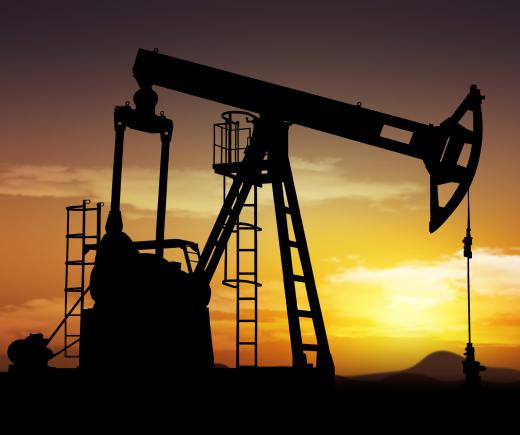A region of land in which vast amounts of oil is extracted from the ground is known as an oil field. The area generally contains oil wells, large machines that bore into the earth to extract petroleum or crude oil. Oil reservoirs, pools of hydrocarbons found in rock formations under the ground, are usually located on large swaths of land, making it necessary for the oil field to extend over a large area. The petroleum is naturally trapped by rock and soil into large pools, which make it possible to set up numerous oil wells in order to permeate the surface.
Logistically, oil fields are complicated to set up and represent one of the most advanced exercises in human technology in the 21st century. Oil fields are generally remote and situated far from civilization. This is due to the fact that crude oil is found most readily in desert areas or underneath the ocean floor.

The oil field rig, the machinery which pumps the oil from the wells, is large and requires extensive manufacturing. Moving the equipment from the location of construction to the oil field can be quite a task. Trucking, shipping and aerial transportation are all utilized to bring the materials to the site. Once on location, the machine must be assembled and a well must be dug. This process from identification of a location to the actual production of oil can take years.

One of the major components that make oil fields function are the human workers that construct the rigs and general machinery designed to gather petroleum. Employees of the companies that operate the fields generally stay on site for months at a time due to transportation limitations. In addition, housing requires electricity, water, heat and other resources. Since the oil fields are distant from civilization, self-sufficient communities are created within the oil field.

Along with oil, most oil fields are also flush with excessive levels of natural gas. This gas needs to be burned off in order to prevent explosion or unwanted fires. Natural gas works very efficiently to power the facilities of the community. It can be pumped all over the vast field and used to make electricity and heat furnaces.
Oil fields are scattered across the globe in many diverse regions. Some are situated in hot deserts such as those in Texas and frigid climates as in Alaska. The largest fields in the world are located in the Middle East, most notably Ghawar Field in Saudi Arabia and Burgan Field in Kuwait. Billions of barrels of oil are produced each year from these fields.
